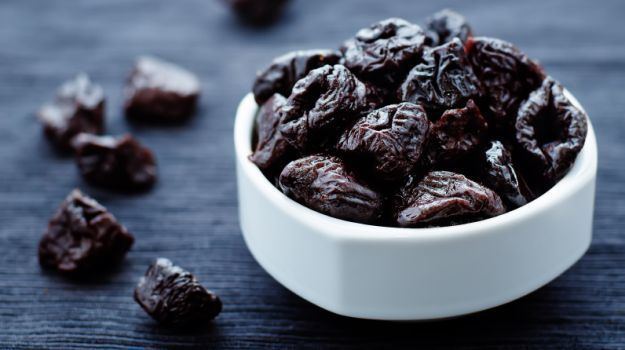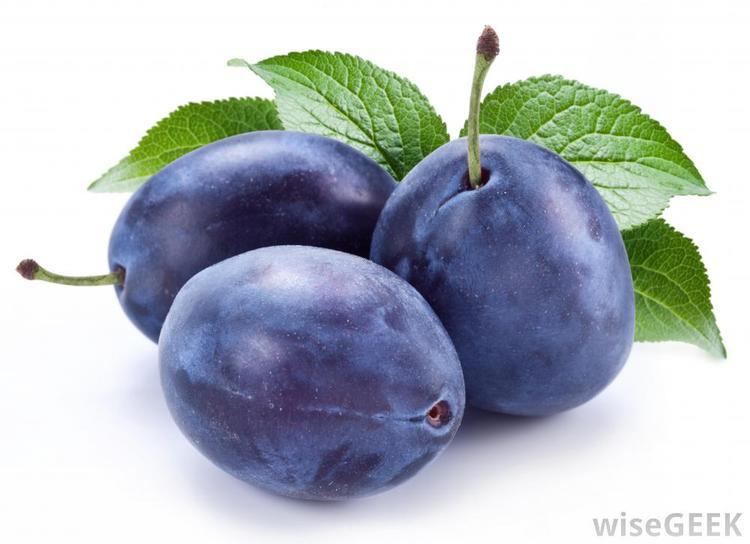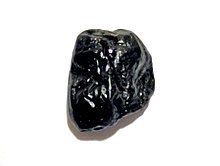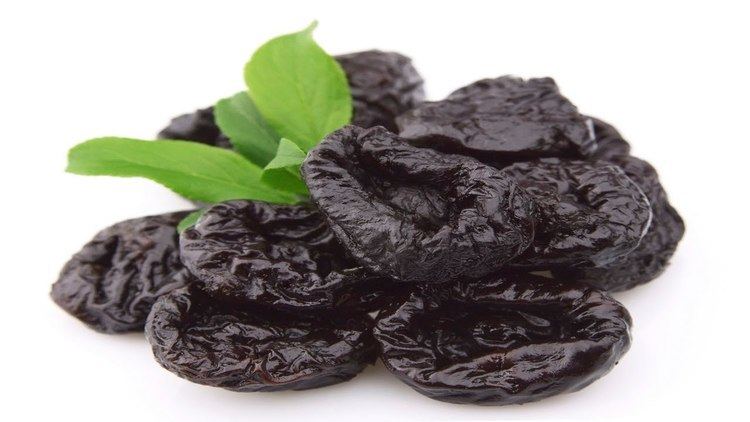Energy 1,006 kJ (240 kcal) Sugars 38.13 g Fat 0.38 g | Carbohydrates 63.88 g Dietary fiber 7.1 g Protein 2.18 g | |
 | ||
Similar Raisin, Dried apricot, Common plum, Date palm, Dried fruit | ||
A prune is a dried plum of any cultivar, mostly Prunus domestica or European Plum. The use of the term for fresh fruit is obsolete except when applied to varieties grown for drying.
Contents
Most prunes are freestone cultivars (the pit is easy to remove), whereas most other plums grown for fresh consumption are clingstone (the pit is more difficult to remove).

Production

More than 1,000 plum cultivars are grown for drying. The main cultivar grown in the United States is the Improved French prune. Other varieties include Sutter, Tulare Giant, Moyer, Imperial, Italian, and Greengage. Fresh prunes reach the market earlier than fresh plums and are usually smaller in size.
Name

In 2001, plum growers in the United States were authorised by the government to call prunes "dried plums". Due to the popular U.S. perception of prunes being used only for relief of constipation, and being the subject of related joking, many distributors stopped using the word "prune" on packaging labels in favour of "dried plums".
Uses

Prunes are used in cooking both sweet and savory dishes. Stewed prunes, a compote, are a dessert. Prunes are a frequent ingredient in North African tagines. Perhaps the best-known gastronomic prunes are those of Agen (pruneaux d'Agen). Prunes are used frequently in Tzimmes, a traditional Jewish dish in which the principal ingredient is diced or sliced carrots; in the Nordic prune kisel, eaten with rice pudding in the Christmas dinner; and in the traditional Norwegian dessert fruit soup. Prunes have also been included in other holiday dishes, such as stuffing, cake, and to make sugar plums. Prune-filled Danish pastries are popular primarily in New York and other parts of the U.S. East Coast. Prune ice cream is popular in the Dominican Republic. Chocolate-covered prunes are a traditional confectionery in Eastern Europe. Prunes are also used to make juice and kompot (uzvar), a traditional drink in Central, Eastern and Southern Europe. In the Cotswolds, prunes were fermented to form a cider-like drink called jerkum. Due to the high sugar content of prunes, it was considered particularly potent as compared to contemporary ciders and beers.
Benefits

Prunes and their juice contain mild laxatives including phenolic compounds (mainly as neochlorogenic acids and chlorogenic acids) and sorbitol. Prunes also contain dietary fiber (about 7%, or 0.07 g per gram of prune). Prunes and prune juice are thus common home remedies for constipation, but a 2010 review by the European Food Safety Authority (EFSA) found that the evidence was "insufficient to establish a cause and effect relationship between the consumption of dried plums of "prune" cultivars (Prunus domestica L.) and maintenance of normal bowel function". A 2012 review by the same body, however, reversed this decision and proposed that prunes did effectively contribute to the restoration of normal bowel function in the general population if consumed in quantities of at least 100g per day (approximately 3-4oz). Prunes also have a high antioxidant content. New studies confirm that consuming prune juice and dried prunes is so good for the bones of the body it has basis for researching as an osteoporosis treatment, as well as reducing blood pressure and arterial plaque build up.
Disadvantages
Prunes have been found to contain "surprising" amounts of acrylamide, a known neurotoxin and a probable carcinogen. Acrylamide does not occur naturally in foods but is formed during the cooking process at temperatures in excess of 100 °C. Although the common drying mechanism of prunes does not involve high temperatures, formation of high amounts of acrylamide has been reported in dried prunes as well as pears.
Although acrylamide has known toxic effects on the nervous system and on fertility, a June 2002 report by the Food and Agriculture Organization of the United Nations and the World Health Organization concluded the intake level required to observe neuropathy (0.5 mg/kg body weight/day) was 500 times higher than the average dietary intake of acrylamide (1 μg/kg body weight/day). For effects on fertility, the level is 2,000 times higher than the average intake. From this, they concluded acrylamide levels in food were safe in terms of neuropathy, but raised concerns over human carcinogenicity based on known carcinogenicity in laboratory animals.
